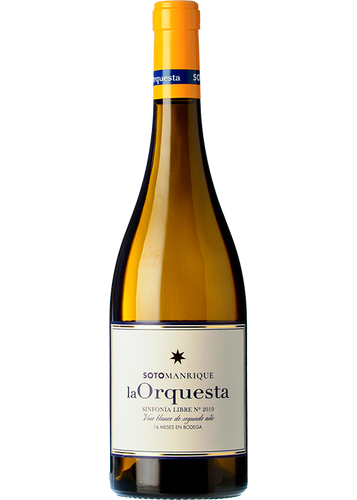| Type | White wine |
|---|---|
| Region | |
| Grapes | |
| Producer | |
| Allergens | Contains sulfites |
| Alcohol contenti | 13.0% |
| Production | 6,000 - 12,000 bottles |

La Orquesta
2019Spec sheet
The wine
Created from an unusual combination of Grenache Blanc, Albillo Real and Verdejo, La Orquesta displays all the character of the Castille and Leon region, bringing together all the complexity of some of its most personal grape varieties.
What does this wine taste like?
An elegant and complex nose blends notes of fennel and mountain herbs alongside hints of nuts, apricots, quince, grapefruit and a touch of wax and honey. Its expressiveness becomes floral over time, with aromas of jasmine, spices, and refreshing citrus hints of mandarin orange, even in the warmest vintages.
It is well-structured with a dense, unctuous, and creamy mouthfeel balanced out by a good level of acidity which adds persistence to the flavours. It displays a rounded palate with an overall sensation of elegance and fine bitter touches, similar to the Verdejo wines produced in the 1990s. Every sip leaves a long and lingering taste of fresh fruit and hay.
| Light | Bold | |
|---|---|---|
| Dry | Sweet | |
| Soft | Acidic |
View | Straw yellow / Steely glints |
|---|---|
Bouquet | Varietal / Fennel / Mint / Citrus fruits / Ageing notes |
Mouth | Unctuous / Good acidity / Balanced / Elegant / Persistent |
Drinking and storing
It is recommended to leave La Orquesta in the glass a while to allow its personality to open up. Its strength and depth mean it is best served at around 10ºC in a wide glass.
It can be enjoyed perfectly well at any time up to five years after its harvest date.
Food pairing
An ideal wine to pair with fish, seafood rice dishes, pasta with creamy sauces, or white meat. It also goes well with cheeses which are not too strong or intense.





Smoked / Aperitifs / Oily fish / Cheeses
Ratings and awards
| 2021 | 93 PK |
|---|---|
| 2019 | 92+ PK |
| 2018 | 93 PK |
| 2016 | 92 PK |
| 2015 | 91 PK |
Customer reviews
Winemaking
Grapes are usually harvested in the second fortnight of September. Part of the wine ferments and ages in wooden foudres on its lees while the other half is fermented in stainless steel tanks and then aged on its lees in 750-litre clay amphoras. Both parts of the wine are aged for between 12 and 16 months.
Bottled in December or January, almost two years after its harvest date.
| Vinification material | Stainless steel / Wood / Amphoras |
|---|---|
| Ageing period | Between 12 and 16 months |
Vineyards
Old vines cultivated organically in the province of Avila. Grenache Blanc and Albillo Real vines are cultivated in Cebreros whereas la Moraña is home to the Verdejo plants.
| Vine age | 25 years |
|---|---|
| Soil | Sand / Limestone |
| Climate | Continental |























